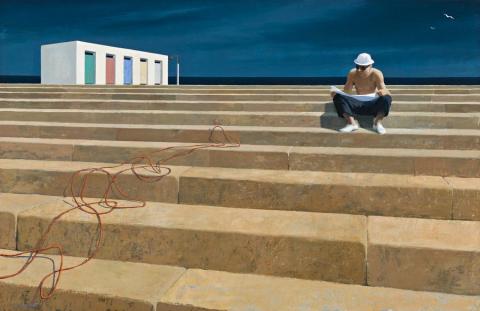OSTIA, 1969-70
JEFFREY SMART
oil on canvas
66.0 x 100.0 cm
signed lower left: JEFFREY SMART
inscribed verso: OSTIA
Leicester Galleries, London
Macquarie Galleries, Sydney (label attached verso)
Private collection, Sydney, acquired from the above in 1981
Sotheby's, Melbourne, 23 November 2009, lot 34
Private collection, Melbourne
Recent Paintings by Jeffrey Smart, Leicester Galleries, London, 5–27 June 1970, cat. 15
Christmas Exhibition, Macquarie Galleries, Sydney, 9–22 December 1970, cat. 24
Easter Exhibition: Pictures for Collectors, Macquarie Galleries, Sydney, 31 March – 19 April 1971, cat. 11
Paintings for Collectors, Macquarie Galleries, Sydney, 9–21 August 1972, cat. 39
Catalogue of an Exhibition of Recent Paintings by Jeffrey Smart, Ernest Brown and Phillips, London, 1970, unpaginated
Looby, K.,'The Absurd Beauty of Reality', Hemisphere, vol. 16, no. 11, November 1972, pp. 20–21 (illus.)
Quartermaine, P., Jeffrey Smart, Gryphon Books, Pty Ltd, Melbourne, 1983, p. 111, cat. 547
McDonald, J., Jeffrey Smart: Paintings of the '70s and'80s, Craftsman House, Sydney, 1990, p. 150, cat. 23
Smart, J., Capon, C., and Greer, G., Jeffrey Smart Drawings and Studies 1942–2001, Australian Galleries, Melbourne, 2001, pp. 85, 197
Allen, C., Jeffrey Smart: Unpublished Paintings, 1940–2007, Australian Galleries, Melbourne, 2008, p. 155 (illus.)
A number of key moments define Jeffrey Smart's long career - his first trip to Europe in 1948, his move to Sydney in 1951 and, most significantly, his one-way trip to Italy in 1965. In leaving Australia Smart left behind a solid career as a teacher and broadcaster, but he yearned for the opportunity to live and work as an artist, unburdened by the day to day grind of earning a living in schools and art classes. In Italy he found the peace and isolation he needed to lift his work from that of a solid but unspectacular practitioner to an artist of the first rank. The culmination of that first five years away was an exhibition at London's Leicester Galleries in 1970, one of only a few exhibitions he was to hold outside Australia. It was a triumph in every respect, with excellent sales and equally impressive reviews. State galleries at home in Australia acquired two of the paintings, the mural City Landscape by the Art Gallery of New South Wales, and the striking Control Tower by the Art Gallery of South Australia. Such purchases were clear proof that Smart might have gone from our shores, but was certainly not forgotten, especially in his hometown. The Art Gallery of South Australia painting was presented by the Friends of the Gallery with the encouragement of John Bailey, a former student of Smart's in Adelaide. Ostia was sold at that exhibition, a work that in every way typifies Smart in the popular imagination.
Jeffrey Smart's Ostia might be seen as an allegory for his own life over the previous decade. As 'Phidias', the art mentor on ABC radio and television for thousands of Australian children, he strode the steps of an imaginary Parthenon, bringing light and wisdom to eager young middle-class minds. A decade later the great steps are made real, leading upward to a concrete temple, a row of bathing boxes with a rank of coloured doors beneath a lowering sky. Phidias is now a relaxed Italian worker, white towelling hatted and bare-chested, at home on the podium as he reads the form guide or the latest political scandal in Rome. As always with Smart, the composition is impeccable, studied and measured with Euclidean precision, the starkness and geometry of the image softened only by a random length of cable snaking up the stairs. Jeffrey Smart was revered as one of our greatest painters, yet spent more than half his life out of the country. His works sold in Australia in impressive quantities at significant prices, yet his subjects were uncompromisingly international. While Arthur Boyd, Fred Williams, John Olsen and John Perceval sought to define an essential Australian-ness in their work, Smart worked just as hard to rid himself of any national or regional references. Of his contemporaries, Smart was probably closest to John Brack, with whom he shared a steadfast belief in the absolute fundamentals of painting - composition, design, line, colour and form.
GAVIN FRY
